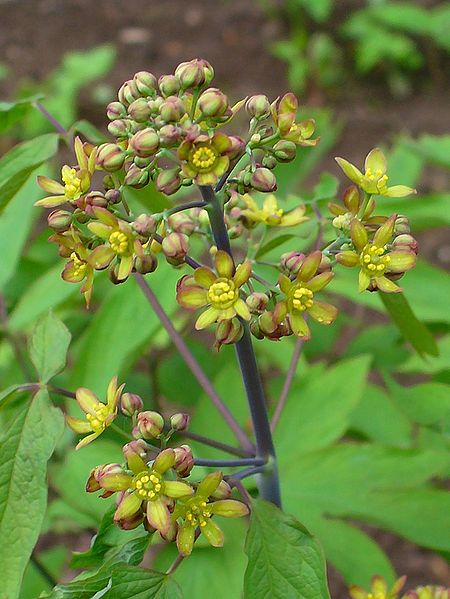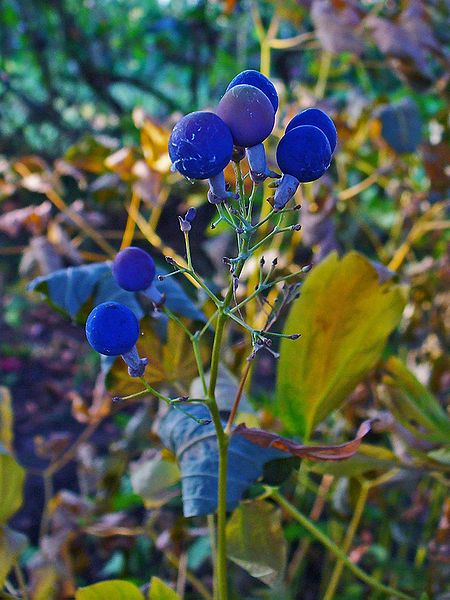 |
|
http://commons.wikimedia.org/wiki/File:Caulophyllum_thalictroides_002.JPG |
 |
| http://commons.wikimedia.org/wiki/File:Caulophyllum_thalictroides_003.JPG |
Translate this page:
Summary
Physical Characteristics

 Caulophyllum thalictroides is a PERENNIAL growing to 0.5 m (1ft 8in) by 1 m (3ft 3in).
Caulophyllum thalictroides is a PERENNIAL growing to 0.5 m (1ft 8in) by 1 m (3ft 3in).
See above for USDA hardiness. It is hardy to UK zone 7. It is in flower in April, and the seeds ripen in September. The species is hermaphrodite (has both male and female organs).
Suitable for: light (sandy) and medium (loamy) soils. Suitable pH: mildly acid, neutral and basic (mildly alkaline) soils. It can grow in full shade (deep woodland) or semi-shade (light woodland). It prefers moist soil.
UK Hardiness Map
US Hardiness Map
Synonyms
Leontice thalictroides L.
Plant Habitats
Woodland Garden Dappled Shade; Shady Edge; not Deep Shade;
Edible Uses
Edible Parts:
Edible Uses: Coffee
The roasted seed is a coffee substitute[4, 102, 105, 177]. The seeds are about the size of large peas, but are not produced in abundance[232].
References More on Edible Uses
Medicinal Uses
Plants For A Future can not take any responsibility for any adverse effects from the use of plants. Always seek advice from a professional before using a plant medicinally.
Anthelmintic Antispasmodic Birthing aid Diaphoretic Diuretic Emmenagogue Oxytoxic Sedative
Papoose root is a traditional herb of many North American Indian tribes and was used extensively by them to facilitate child birth[207]. Modern herbalists still consider it to be a woman's herb and it is commonly used to treat various gynaecological conditions[254]. An acrid, bitter, warming herb, it stimulates the uterus, reduces inflammation, expels intestinal worms and has diuretic effects[238]. The root is anthelmintic, antispasmodic, diaphoretic, diuretic, emmenagogue, oxytocic and sedative[4, 21, 46, 165, 207]. An infusion of the root in warm water is taken for about 2 weeks before the expected birth date in order to ease the birth[207, 213]. This infusion can also be used as an emmenagogue and a uterine stimulant[213]. Papoose root should therefore be used with some caution by women who are in an earlier stage of pregnancy since it can induce a miscarriage or early delivery[222]. The plant is also taken internally in the treatment of pelvic inflammatory disease, rheumatism and gout[238]. It should not be prescribed for people with hypertension and heart diseases[238]. The powdered root can have an irritant action on the mucous membranes, therefore any use of this plant is best under the supervision of a qualified practitioner[238, 268]. The roots are normally harvested in the autumn, because they are at their richest at this time[213], and are dried for later use. The root is harvested in early spring as new growth is beginning and is used to make a homeopathic remedy[232]. It is used especially in childbirth and in some forms of rheumatism[232].
References More on Medicinal Uses
The Bookshop: Edible Plant Books
Our Latest books on Perennial Plants For Food Forests and Permaculture Gardens in paperback or digital formats.

Edible Tropical Plants
Food Forest Plants for Hotter Conditions: 250+ Plants For Tropical Food Forests & Permaculture Gardens.
More

Edible Temperate Plants
Plants for Your Food Forest: 500 Plants for Temperate Food Forests & Permaculture Gardens.
More

More Books
PFAF have eight books available in paperback and digital formats. Browse the shop for more information.
Shop Now
Other Uses
References More on Other Uses
Cultivation details
Easily grown in a damp light humus-rich woodland soil preferring a position in deep shade[1, 200]. One report says that it is best in a peat garden. Plants are hardy to at least -20°c[187]. The plant only produces one large leaf each year[233]. The seeds rupture the ovary before they are fully ripe and continue to expand naked, they are bright blue when fully ripe[130].
References Carbon Farming Information and Carbon Sequestration Information
Temperature Converter
Type a value in the Celsius field to convert the value to Fahrenheit:
Fahrenheit:
The PFAF Bookshop
Plants For A Future have a number of books available in paperback and digital form. Book titles include Edible Plants, Edible Perennials, Edible Trees,Edible Shrubs, Woodland Gardening, and Temperate Food Forest Plants. Our new book is Food Forest Plants For Hotter Conditions (Tropical and Sub-Tropical).
Shop Now
Plant Propagation
Seed - best sown as soon as it is ripe in a shady part of a cold frame[200]. If stored seed is used, it should be sown as soon as it is received. Germination can be erratic. Prick out the seedlings as soon as they are large enough to handle and grow them on in a shady part of a greenhouse or cold frame for at least their first winter. Plant them out into their permanent positions during autumn or early winter. Division in spring or just after flowering[200]. Plants are slow to increase[187].
Other Names
If available other names are mentioned here
Native Range
NORTHERN AMERICA: Canada (New Brunswick, Ontario, Québec, Manitoba), United States (Connecticut, Indiana, Maine, Massachusetts, Michigan, New Hampshire, New Jersey, New York, Ohio, Pennsylvania, Vermont, West Virginia, Illinois, Iowa, Kansas, Minnesota, Missouri, Nebraska, North Dakota, South Dakota, Wisconsin, Alabama, Arkansas, Delaware, District of Columbia, Georgia, Kentucky, Maryland, North Carolina, South Carolina, Tennessee, Virginia)
Weed Potential
Right plant wrong place. We are currently updating this section.
Please note that a plant may be invasive in one area but may not in your area so it's worth checking.
Conservation Status
IUCN Red List of Threatened Plants Status :

Growth: S = slow M = medium F = fast. Soil: L = light (sandy) M = medium H = heavy (clay). pH: A = acid N = neutral B = basic (alkaline). Shade: F = full shade S = semi-shade N = no shade. Moisture: D = dry M = Moist We = wet Wa = water.
Now available:
Food Forest Plants for Mediterranean Conditions
350+ Perennial Plants For Mediterranean and Drier Food Forests and Permaculture Gardens.
[Paperback and eBook]
This is the third in Plants For A Future's series of plant guides for food forests tailored to
specific climate zones. Following volumes on temperate and tropical ecosystems, this book focuses
on species suited to Mediterranean conditions—regions with hot, dry summers and cool, wet winters,
often facing the added challenge of climate change.
Read More
Expert comment
Author
(L.)Michx.
Botanical References
43200
Links / References
For a list of references used on this page please go here
Readers comment
| Add a comment |
|
If you have important information about this plant that may help other users please add a comment or link below. Only comments or links that are felt to be directly relevant to a plant will be included. If you think a comment/link or information contained on this page is inaccurate or misleading we would welcome your feedback at [email protected]. If you have questions about a plant please use the Forum on this website as we do not have the resources to answer questions ourselves.
* Please note: the comments by website users are not necessarily those held by PFAF and may give misleading or inaccurate information.
To leave a comment please Register or login here All comments need to be approved so will not appear immediately.
|
Subject : Caulophyllum thalictroides
|
|
|
|